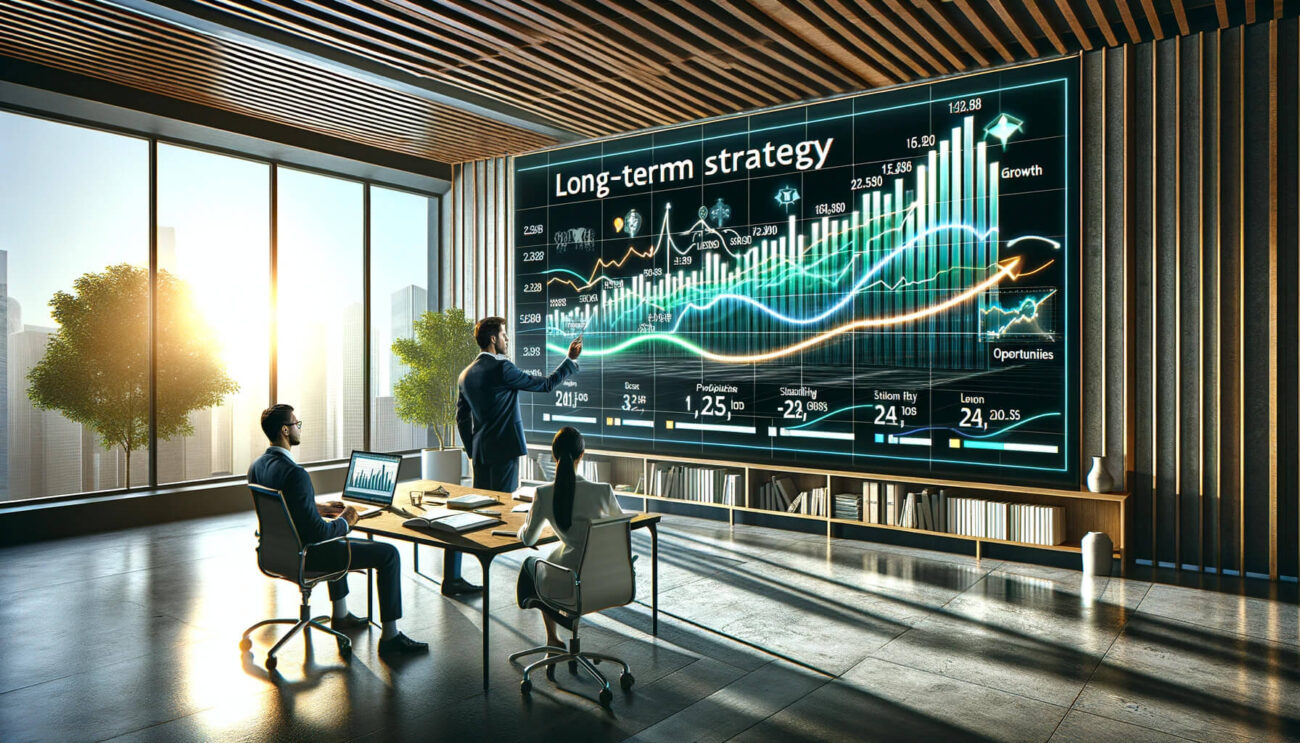Did you know that 90% of new traders fail within the first year of entering the market? The world of trading is complex and volatile, making it challenging for beginners to navigate successfully. However, there is a proven method that can significantly increase your chances of success: simulated trading. In this article, we will explore the concept of virtual trading and how it can be a powerful tool for traders looking to enhance their skills and gain confidence before entering the real market.
What is Simulated Trading?
Simulated trading is a powerful tool for traders looking to enhance their skills and gain confidence before entering the real market. It provides a realistic environment for traders to practice buying and selling assets without risking real money.
With paper trading, traders can test their strategies, explore different trading techniques, and analyze market trends. By simulating real trading scenarios, traders can get hands-on experience without the fear of financial loss. It’s like a virtual playground for traders, where they can learn and grow without any pressure.
There are various platforms and software available for simulated trading, catering to traders with different preferences and experience levels. These platforms offer a wide range of features, including real-time market data, historical price charts, and customizable trading interfaces.
Simulated trading provides a safe space for traders to learn from their mistakes, refine their strategies, and build the confidence they need to succeed in the real market.
Whether you’re a beginner just starting your trading journey or an experienced trader looking to improve your skills, paper trading can be a valuable tool for honing your trading abilities. It allows you to practice and experiment with different trading techniques, explore new markets, and gain a deeper understanding of how the markets work.
So, if you’re ready to take your trading to the next level, dive into the world of virtual trading and unleash your trading potential.
Benefits of Simulated Trading
Simulated trading offers traders a range of benefits that can significantly enhance their trading skills and overall performance in the market. Whether you are a beginner looking to learn the ropes or an experienced trader seeking to refine your strategies, virtual trading provides a valuable training tool that mimics real market scenarios without the risk of losing real money.
Here are some key benefits of simulated trading:
- Testing Different Strategies: Paper trading allows traders to experiment with various strategies and tactics. By testing different approaches, traders can gain insights into the strengths and weaknesses of their strategies, understand how they perform in different market conditions, and make more informed decisions when trading with real money.
- Analyzing Market Trends: Virtual trading provides traders with the opportunity to analyze market trends and patterns. By closely observing price movements, trading volumes, and other market indicators, traders can develop a better understanding of market dynamics and improve their ability to predict future price movements.
- Valuable Training Tool: Simulated trading serves as a valuable training tool for both beginner and experienced traders. It allows beginners to familiarize themselves with the trading process, learn how to execute trades and understand the impact of different market factors on asset prices. For experienced traders, simulated trading offers an avenue to refine their skills, test new strategies, and adapt to changing market conditions.
“Paper trading provides traders with a risk-free environment to hone their skills and gain confidence in their trading abilities.”
Simulated trading provides a stress-free environment where traders can learn from their mistakes and gain confidence in their abilities. It offers the opportunity to develop discipline, patience, and emotional control – all essential qualities for successful trading in real-world markets.
Ultimately, virtual trading enables traders to bridge the gap between theory and practice. It allows them to apply their knowledge, test their strategies, and gain practical experience in a risk-free environment before venturing into live trading with real money.
Building Confidence through Simulated Trading
In the world of trading, confidence is key. However, building confidence takes practice and experience. This is where simulated trading comes in. Virtual trading provides traders with a risk-free environment to make mistakes, learn from them, and ultimately build confidence.
The Power of Learning from Mistakes
Paper trading allows traders to explore different strategies and make mistakes without risking their hard-earned money. As the saying goes, “Practice makes perfect.” By making mistakes in a simulated environment, traders can learn valuable lessons and avoid repeating those mistakes in real trading.
“Paper trading gives you the freedom to experiment and learn from your mistakes without any financial consequences. It’s a safe space to push boundaries and refine your trading approach.”
Refining Trading Strategies
Simulated trading is not only about making mistakes but also about refining trading strategies. Traders can test different strategies, analyze their performance, and make adjustments as needed. This process allows traders to find a strategy that suits their trading style and goals, ultimately boosting their confidence in executing successful trades.
Developing a Disciplined Mindset
Trading requires discipline and emotional control. Virtual trading can help traders develop these essential traits. By practicing in a simulated environment, traders can learn to stick to their trading plans, manage their emotions, and avoid impulsive decisions. This disciplined mindset can greatly enhance a trader’s confidence when transitioning to real trading.
List of Benefits:
- Provides a risk-free environment to make mistakes and learn from them
- Allows traders to experiment with different strategies
- Helps traders refine their trading approaches
- Develops discipline and emotional control
- Boosts confidence in real trading scenarios
Testing Trading Strategies with Simulated Trading
Simulated trading provides traders with a unique opportunity to test and refine their trading strategies before entering the real market. By utilizing virtual trading platforms, traders can gauge the effectiveness of their strategies and make adjustments as needed, ensuring they are well-prepared for real trading scenarios.
One of the key benefits of paper trading is the ability to test different trading strategies across various market conditions. Whether you rely on technical analysis or fundamental analysis, simulated trading allows you to experiment with different approaches and evaluate their performance.
Technical analysis enthusiasts can utilize simulated trading to test out different technical indicators and chart patterns. By applying these indicators and patterns to past market data, traders can analyze the outcomes and determine which strategies are most effective in predicting price movements.
On the other hand, fundamental analysis traders can leverage virtual trading to evaluate the impact of various fundamental factors on asset prices. By simulating trades based on financial statements and economic data, traders can gain insights into how these factors influence market trends and adjust their strategies accordingly.
Virtual trading also provides an opportunity for traders to identify the strengths and weaknesses of their strategies. By analyzing the results of simulated trades, traders can pinpoint areas that require improvement and make necessary adjustments without risking real money. This iterative process of testing and refining strategies is vital for long-term trading success.
Benefits of Testing Trading Strategies with Simulated Trading:
- Opportunity to experiment with different trading strategies
- Evaluation of the effectiveness of technical analysis and fundamental analysis
- Identification of strengths and weaknesses in trading strategies
- Ability to make adjustments without risking real money
- Iterative process for refining strategies and enhancing trading performance
Virtual trading acts as a sandbox for traders, allowing them to test and fine-tune their strategies in a risk-free environment. By taking advantage of this powerful tool, traders can gain confidence and improve their overall trading performance, ultimately leading to success in the real market.
Simulated Trading for Technical Analysis
Simulated trading platforms offer traders a unique opportunity to sharpen their skills in technical analysis. By utilizing these platforms, traders can effectively test and analyze various technical indicators and chart patterns, gaining valuable insights into market trends.
One of the key advantages of virtual trading for technical analysis is the ability to experiment with different indicators in a risk-free environment. Traders can test popular indicators such as moving averages, oscillators, and Bollinger Bands to understand their effectiveness in predicting price movements.
Paper trading also allows traders to identify and analyze chart patterns, which can provide valuable signals for entry and exit points. Patterns like double tops and bottoms, head and shoulders, and ascending and descending triangles can be studied and tested extensively to gain a deeper understanding of their significance.
Moreover, through simulated trading, traders can develop their skills in recognizing trends and patterns on different timeframes. This can greatly enhance their ability to make informed trading decisions based on technical analysis.
“Technical analysis is like a compass that guides traders in the right direction. Simulated trading allows you to fine-tune your compass, ensuring accuracy and confidence in your analysis.”
Another advantage of simulated trading for technical analysis is the ability to backtest trading strategies. Traders can apply their technical analysis skills to historical market data and see how their strategies would have performed in real-life scenarios. This retrospective analysis can provide valuable insights into the strengths and weaknesses of a trading strategy.
Harnessing the power of simulated trading for technical analysis can significantly improve a trader’s ability to identify trends, make better entry and exit decisions, and adapt to changing market conditions. It allows traders to gain practical experience and build confidence in their technical analysis skills before venturing into the real market.
Key Takeaways:
- Simulated trading offers a realistic platform to practice and refine technical analysis skills.
- Traders can experiment with different technical indicators and chart patterns without risking real money.
- Simulated trading allows for backtesting of trading strategies to assess their historical performance.
- Developing proficiency in technical analysis through simulated trading can enhance decision-making and adaptability in the real market.
Simulated Trading for Fundamental Analysis
Simulated trading is not just limited to technical analysis. It can also be a valuable tool for traders who rely on fundamental analysis to make informed investment decisions. By utilizing simulated trading platforms, traders can evaluate financial statements, economic data, and other fundamental factors that impact asset prices.
One of the key benefits of simulated trading for fundamental analysis is the ability to test different investment strategies based on fundamental indicators. Traders can conduct in-depth analyses of companies’ financial health, evaluate market trends, and monitor economic events in a risk-free environment.
“Simulated trading allows me to assess the impact of various fundamental factors on asset prices without risking real money. It helps me refine my investment strategies and make more informed decisions.”
Simulated trading also provides an opportunity to understand the fundamental drivers behind price movements in different markets. Traders can analyze economic news releases, assess the impact of company earnings reports, and study the effects of government policies on asset prices.
Benefits of Simulated Trading for Fundamental Analysis:
- Ability to evaluate financial statements and assess the financial health of companies.
- Opportunity to analyze economic data and understand its impact on asset prices.
- Platform to test different investment strategies based on fundamental indicators.
- Practice monitoring and reacting to market news and events.
- Risk-free environment for learning and improving fundamental analysis skills.
Simulated trading for fundamental analysis allows traders to gain a deeper understanding of how various fundamental factors shape the market. It helps them develop a systematic approach to analyzing and interpreting financial data, which can ultimately enhance their ability to make better investment decisions in the real market.
Developing a Winning Trading Strategy with Simulated Trading
Simulated trading is not only a valuable tool for practicing trading skills but also for developing and refining winning trading strategies. By utilizing simulated trading platforms, traders can gain insights into market dynamics, analyze past data, and identify patterns that can enhance their overall trading performance.
The Importance of Backtesting
One of the key aspects of developing a winning trading strategy is backtesting. Simulated trading provides traders with the opportunity to test their strategies using historical market data. By analyzing past data, traders can identify patterns, understand the effectiveness of their strategies, and make necessary adjustments. Backtesting allows traders to gain confidence in their strategies before applying them in real market scenarios.
Analyzing Past Data
Simulated trading offers traders the ability to analyze past market data in a risk-free environment. By studying how different assets have performed in the past, traders can gain insights into market trends, volatility, and potential opportunities. This analysis can help traders make informed decisions and develop robust trading strategies that have a higher probability of success.
“Paper trading provides traders with a unique opportunity to analyze past data and gain insights into market dynamics without the fear of losing real money. This analytical approach can significantly improve trading strategies and overall performance.”
Identifying Patterns
Virtual trading allows traders to identify patterns in market movements, asset prices, and trading indicators. By recognizing recurring patterns, traders can develop strategies that capitalize on these trends, increasing their chances of making profitable trades. Whether it’s technical indicators or chart patterns, simulated trading provides a platform for pattern recognition and strategy refinement.
Continuous Improvement and Strategy Refinement
Simulated trading is an ongoing process that enables traders to continuously refine their strategies and adapt to changing market conditions. By regularly analyzing the performance of their trading strategies in a simulated environment, traders can make adjustments, discard ineffective approaches, and embrace new methodologies. This continuous improvement process is vital in staying competitive and achieving consistent profitability in the real trading world.
Virtual trading offers traders a powerful platform for developing and refining their trading strategies. By utilizing backtesting, analyzing past data, and identifying patterns, traders can improve their overall trading performance and increase their chances of success in the real market. With the ability to continuously refine strategies, simulated trading plays a crucial role in helping traders develop winning trading strategies.
Overcoming Emotional Biases with Simulated Trading
When it comes to trading, emotional biases can often cloud judgment and lead to poor decision-making. Fear, greed, and impatience are just a few of the emotions that can derail a trader’s success. However, with simulated trading, traders have a powerful tool at their disposal to overcome these biases and cultivate a disciplined mindset.
The importance of trading psychology cannot be overstated. Controlling emotions and making rational decisions are essential skills for any trader. Virtual trading provides a risk-free environment where traders can practice managing their emotions and building resilience in the face of market fluctuations.
“Simulated trading allows traders to experience the psychological aspects of trading without real financial risk. It provides an opportunity to recognize and address emotional biases that may hinder performance in the real market.”
Through simulated trading, traders can develop strategies to navigate high-pressure situations and maintain composure during volatile market conditions. By simulating real trading scenarios, traders can identify their emotional triggers and implement techniques to effectively manage stress and anxiety.
Moreover, simulated trading allows traders to learn from their mistakes without financial consequences. It is a safe space to experiment with different approaches and observe the impact of emotional biases on trading outcomes. Traders can reflect on their decisions, analyze the consequences, and make adjustments accordingly.
The Benefits of Simulated Trading for Emotional Bias Training:
- Provides a risk-free environment to practice managing emotions
- Allows traders to identify and address emotional biases
- Helps build resilience and discipline in the face of market fluctuations
- Enables reflection and learning from mistakes without financial consequences
As legendary investor Warren Buffett once said, “The most important quality for an investor is temperament, not intellect.” Simulated trading offers traders the opportunity to develop the right temperament by honing their emotional control skills.
By incorporating simulated trading into their training regimen, traders can cultivate a disciplined mindset, overcome emotional biases, and make more rational decisions when navigating the real market.
Transitioning from Simulated Trading to Real Trading
After spending time practicing in a virtual trading environment, it’s natural to wonder how to transition to real trading with confidence. The skills and knowledge acquired through simulated trading can be invaluable when applied to real market scenarios. Here are some tips and guidance to help you make a smooth transition:
- Start with a small capital: Begin by trading with a smaller amount of real money that you are comfortable with. This will allow you to gain real-world experience without risking a significant portion of your capital.
- Focus on your strategy: Stick to the trading strategy that has proven successful during your simulated trading sessions. Avoid making impulsive decisions or deviating from your plan based on short-term fluctuations.
- Monitor your emotions: It’s important to keep your emotions in check when transitioning to real trading. Be aware of any signs of fear, greed, or anxiety, and take steps to manage them effectively.
- Implement proper risk management: Apply the risk management techniques you practiced during simulated trading. Set stop-loss orders, determine your risk tolerance, and establish a solid risk-reward ratio for each trade.
- Keep learning: The transition to real trading should not mark the end of your learning journey. Continuously educate yourself on market trends, new trading strategies, and industry developments to stay ahead of the curve.
Remember that even though simulated trading provides a realistic environment, real trading involves real money and emotions. Stay disciplined, stick to your plan, and adapt as needed.
By following these tips and applying the skills you’ve acquired through paper trading, you’ll be on your way to becoming a confident and successful real trader. Make the most of this transition by combining your acquired knowledge with market insights and ongoing practice.
Simulated Trading as a Continuous Learning Tool
Virtual trading is not just for beginners; it is a valuable tool that can benefit experienced traders as well. Using simulated trading as a continuous learning tool can help traders refine their strategies and stay adaptable in a constantly changing market.
By continually practicing and experimenting with different approaches in a simulated trading environment, traders can gain valuable insights into what works and what doesn’t. They can test new strategies, analyze market trends, and adapt their trading techniques to optimize their performance.
One of the key advantages of using virtual trading as a continuous learning tool is the ability to refine existing strategies. Traders can evaluate their past trades, identify patterns, and make adjustments to improve their overall trading approach. This iterative process of testing, analyzing, and refining allows traders to constantly fine-tune their strategies and stay ahead of the curve.
“Paper trading provides a safe environment for traders to experiment and learn from their mistakes, without putting their hard-earned money at risk.”
Another benefit of using simulated trading as a continuous learning tool is the opportunity to adapt to changing market conditions. Markets are dynamic, and what works today may not work tomorrow. Virtual trading allows traders to stay agile by testing different strategies and adjusting their approach based on current market trends and conditions.
Simulated trading also serves as a valuable platform for traders to test new ideas and explore different trading styles. Whether it’s incorporating technical analysis, fundamental analysis, or a combination of both, traders can experiment with various approaches in a risk-free environment. This enables them to expand their trading skills and broaden their knowledge base.
Benefits of VirtualTrading as a Continuous Learning Tool:
- Opportunity to refine and optimize existing trading strategies
- Adaptability to changing market conditions
- Safe environment for testing new ideas and exploring different trading styles
- Continuous improvement of trading skills and knowledge
- Enhanced confidence in real trading scenarios
Virtual trading is not just a stepping stone for beginners; it is a powerful tool that can be used throughout a trader’s career. By using simulated trading as a continuous learning tool, traders can refine their strategies, adapt to changing market conditions, and stay one step ahead in the competitive world of trading.
Conclusion
In conclusion, simulated trading provides traders with a unique opportunity to refine their skills and test different trading strategies in a risk-free environment. By offering a realistic platform to practice buying and selling assets, simulated trading allows traders to gain valuable experience without the fear of losing real money.
One of the significant advantages of virtual trading is its versatility in accommodating various trading strategies, including both technical analysis and fundamental analysis. Traders can utilize simulated trading to test different approaches and optimize their trading strategies accordingly. Whether you prefer analyzing market trends using technical indicators or evaluating fundamental factors such as financial statements and economic data, simulated trading offers a safe space to explore and fine-tune your approach.
Virtual trading is not limited to beginners; experienced traders can also benefit from using this training tool. It enables traders to build confidence, overcome emotional biases, and develop a disciplined mindset. Additionally, traders can continuously enhance their skills and adapt to changing market conditions using simulated trading as an ongoing learning tool.
In summary, simulated trading is a valuable resource for traders of all levels. It provides a practical environment to practice trading strategies, including technical analysis and fundamental analysis. By utilizing simulated trading, traders can gain confidence, refine their skills, and develop a winning trading strategy, positioning themselves for success in the real market.







